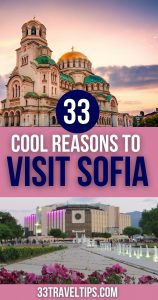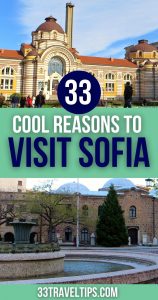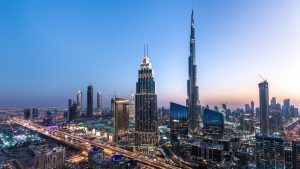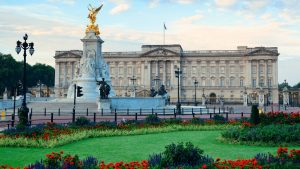
If you’re wondering whether to put the Bulgarian capital on your travel wish list, know this:
Sofia is worth visiting for its incredible historical, cultural, and natural attractions. Architecture buffs will love the imposing Alexander Nevsky Cathedral; nature lovers – the splendid Vitosha Mountain and Borisova Gradina; and culture vultures – the variety of museums and archaeological sites.
In this article, you’ll find the top 33 reasons to visit Sofia, Bulgaria. By the end of the guide, you’ll know why you should travel to the Bulgarian capital.
Ready to explore?
Let’s begin!
✅ Note: This article contains affiliate links. In case you purchase something through one of these links, we may receive a small commission at no extra cost to you. Thank you for helping us keep creating the free content on this website!
Visit Sofia for the Spectacular Attractions

Roman ruins, mineral springs, and Viennese-style architecture await you in the capital city of Bulgaria. These spectacular attractions are just a few of the reasons to visit Sofia. Discover them in the following section.
- Ancient Roman ruins. Modern Sofia sits on the remains of the old city of Serdica. Roman ruins dating from the 4th – 6th centuries dot the city center. And the good news is, you can wander around them for free. Find the most remarkable archaeological sites near the Saint Sofia Monument. Peculiarly, the luxury Arena di Serdica Boutique Hotel hosts the ruins of Serdica Amphitheater, one of the largest in the Eastern Roman Empire.
- National Palace of Culture. The modern building hosts the biggest multifunctional conference and exhibition center in southeastern Europe. The National Palace of Culture (NDK) was inaugurated in 1981 in celebration of Bulgaria’s 1,300th anniversary. NDK features 13 halls and 161,460 sq. ft. (15,000 sq. m) of exhibition area, covering eight floors and three underground levels. Surrounding the building, you can admire playful fountains, green spaces, outdoor cafés, and interesting monuments.
- Sofia’s hot mineral springs. Only a handful of world capitals boast hot mineral springs. Sofia is one of them. You can find mineral water fountains at various locations throughout the city. The most famous drinking fountains are near the Sofia Central Mineral Baths. The hot water is great for satiating your thirst and easing various health issues, such as an upset stomach.
- The bridges of Sofia. Sofia prides itself on two stunning bridges. The Lions’ Bridge connects the Central Railway Station with Sofia’s center and marks the city’s northern border. Four colossal bronze lions adorn each side of the bridge. The Eagles’ Bridge features eagle figures with spread wings on its ends. They symbolize the longing for freedom. The Eagles’ Bridge used to be one of the two symbolic entries into the old city of Sofia.
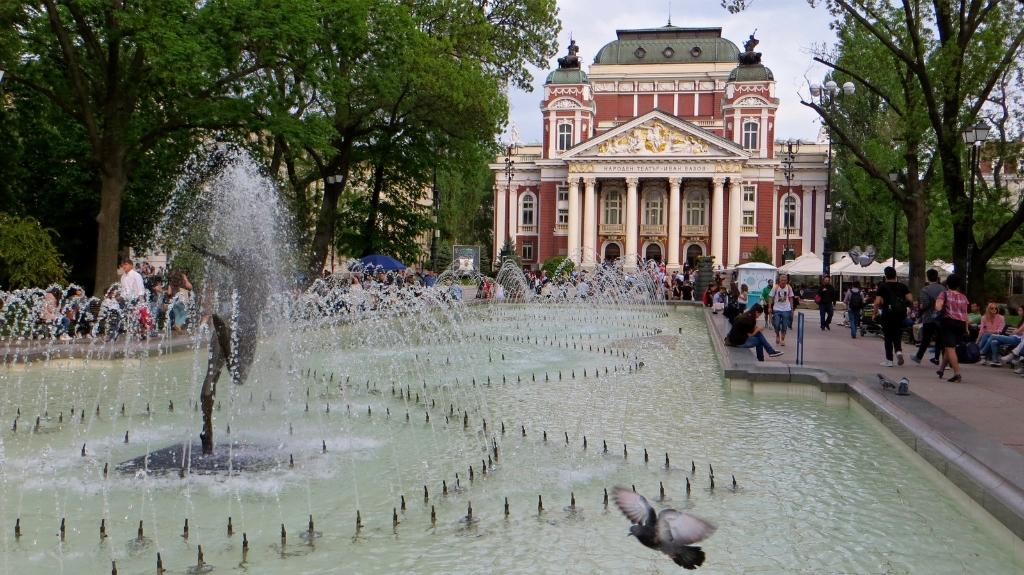
- Ivan Vazov National Theater. Named after the most important Bulgarian writer and poet, the red-colored Neoclassical building is one of the most stunning structures in Sofia. It’s the heart of the cultural life in the Bulgarian capital. In front, you’ll find a large square and a spectacular fountain. The charming City Garden, which is a favorite spot for locals and tourists, surrounds the area.
- St. Sofia Monument. This imposing bronze statue overlooks Sofia’s downtown. Built in 2000, it’s one of the most recognizable spots in the capital. Saint Sofia wears three important symbols. The crown represents power, the wreath stands for fame, and the owl – for wisdom. Tip: The yellow-bricked road that leads from the monument stretches past many of Sofia’s attractions. The yellow stones are iconic for the Bulgarian capital.
- Sofia Central Mineral Baths. Until 1986, this gorgeous structure served as Sofia’s public bathhouse. The design balances Vienna Secession style with Bulgarian, Byzantine, and Eastern Orthodox elements. Nowadays, the building hosts the Regional History Museum Sofia, which showcases the capital’s rich history. Next to the entrance, you can fill your drinking bottle at the mineral water fountains.
- National Art Gallery. Even if you don’t want to enter the gallery, make sure to check the building’s exterior. The National Art Gallery occupies a fabulous royal palace with Viennese Neo-Baroque elements. Inside Bulgaria’s largest gallery, you can marvel at more than 50,000 pieces of Bulgarian art from the Middle Ages to the present day.
Explore Sofia for the Diverse Religious Temples
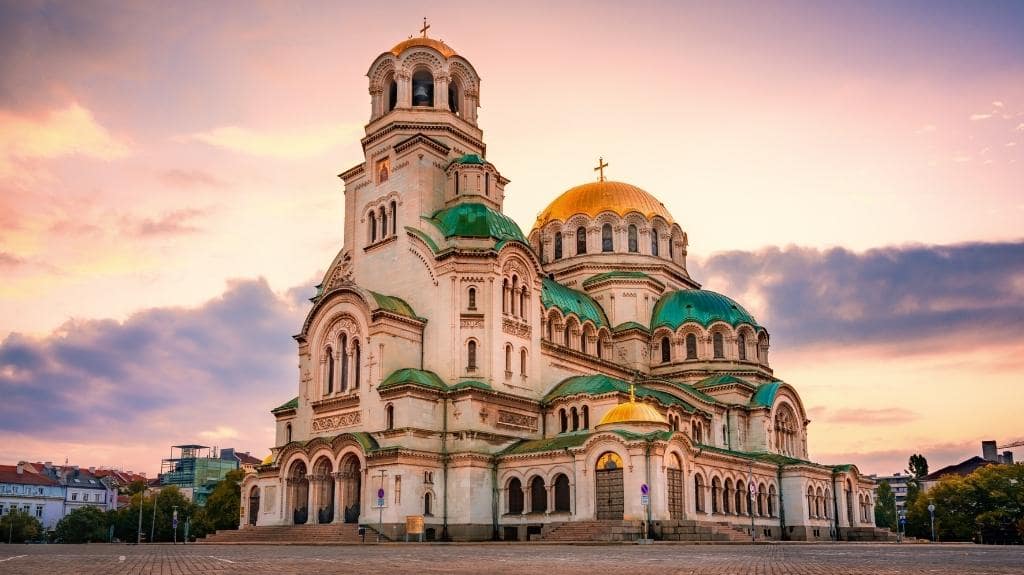
Bulgaria prides itself on the religious diversity and tolerance of its people. In Sofia, you can visit temples of almost all major religions. Submerge yourself in Sofia’s rich history by exploring its religious sites.
- Alexander Nevsky Cathedral. One of the largest Orthodox cathedrals worldwide, and the largest in Bulgaria, epitomizes the New-Byzantine style. Built in 1912, it’s the most famous attraction Sofia is known for. If you’re arriving by plane, you’ll recognize the iconic golden domes from the air. The interior features ornate thrones and marble pillars of various colors. Check out Alexander Nevsky’s Crypt Museum below the cathedral, which hosts a vast collection of Orthodox icons and religious objects.
- St. George’s Rotunda. Hidden between the Presidency, the Ministry of Education, and Sofia Hotel Balkan, you’ll find Sofia’s oldest church and one of the most ancient in Europe. The red-bricked St. George’s Rotunda was built in the 4th century. After visiting the church, wander the remnants of a Roman street and residential buildings that surround it.
- St. Sofia Church. You’ll find this Byzantine temple near the Alexander Nevsky Cathedral. The 6th-century church boasts a gigantic chamber adorned with massive icons. Underneath it, you can visit one of the most staggering archaeological sites in Sofia. Below the church lies a necropolis, containing more than 50 tombs dating back to the 3rd century BC.
- The Sofia Synagogue. This impressive building in the city center is the largest Sephardic synagogue in Europe. It’s also the second-largest synagogue on the continent after the Dohány Street Synagogue in Budapest. The Sofia Synagogue represents the Bulgarian National Romanticism architectural style. It was erected at the beginning of the 20th century.

- Church of St. Nicholas, the Miracle-Maker. Widely referred to as the Russian Church, this colorful temple is among Sofia’s most vibrantly decorated structures. The façade and the inside of the church are richly adorned with gold, marble, and shiny tiles. The traditional onion-shaped domes make the Russian Church stand out among its surrounding buildings.
- Banya Bashi Mosque. The architect Kodja Mimar Sinan who worked on the most famous mosques in the Ottoman Empire also designed Banya Bashi Mosque. The central mosque of Sofia was originally a part of a bigger bath complex. That’s the reason for its name: “banya” translates to bath. Inside the mosque, you can admire intricate floral decorations and creative Quran inscriptions.
- Boyana Church. The UNESCO World Heritage Boyana Church was built in the 10th century. Although small, the temple’s historic and cultural value is enormous. Stunning frescoes from the 11th and 12th centuries decorate its walls. The medieval art features priceless life-like depictions of Bulgarian monarchs and saints. Tip: To preserve the fragile art, visits are limited to 8-10 people and last about 10 minutes. The entrance is free on Mondays after 3:00 PM. Alternatively, buy a combo ticket for the Boyana Church and the National History Museum, which is nearby.
Travel to Sofia for the Extraordinary Museums
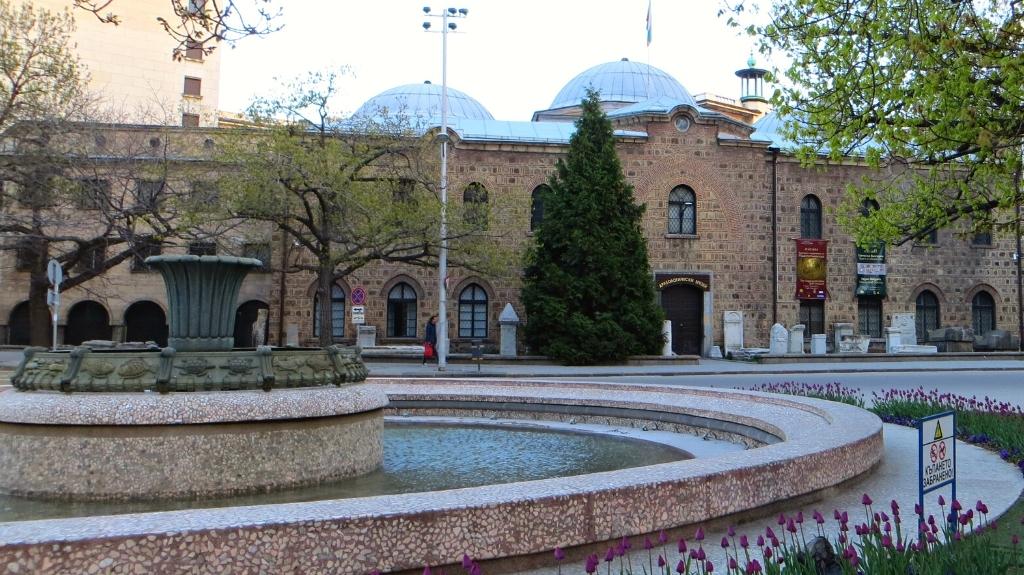
If you like exploring peculiar museums, then Sofia is worth visiting for the variety of unusual exhibitions. Historical and archaeological collections coexist with technical and military displays. Find out the most interesting museums of Sofia below.
- National Historical Museum. Bulgaria’s largest museum contains over 650,000 objects. The collections of the National Historical Museum in Sofia (NHM) showcase fine arts, history, archaeology, and ethnography. The most thrilling exhibits include Ancient Thracian gold treasures, such as the opulent Valchitran Treasure and the Panagyurishte Treasure. Tip: We recommend purchasing the 12.00 BGN ($6.15) combined ticket to gain access to both the NHM and the UNESCO-listed Boyana Church.
- National Archaeological Museum. Located in the heart of Sofia across the Presidency building, you’ll see the National Archaeological Museum. The exhibition occupies the oldest and largest preserved mosque of Sofia – Koca Mahmut Paşa Camii. Today, the National Archaeological Museum consists of five collections – Prehistory, Middle Ages, Treasure, Central, and a special temporary exhibition.
- Earth and Man National Museum. The 20,000+ items on display make the Earth and Man National Museum one of the largest mineralogical museums on the planet. You’ll discover it near the National Palace of Culture. The museum opened its doors in 1987. Its collection includes more than 40% of the world’s naturally occurring minerals. In the museum’s exhibition halls, you can marvel at gigantic quartz, tourmaline, and amethyst stones.
- National Museum of Natural History. The National Museum of Natural History displays almost 1.5 million specimens of plants, animals, and minerals. Its vast collection makes it the richest natural history museum on the Balkans. You can explore 15 halls on 4 floors. Don’t miss seeing the extinct monk seal, steppe viper, German sturgeon, and the Caroline parrot.
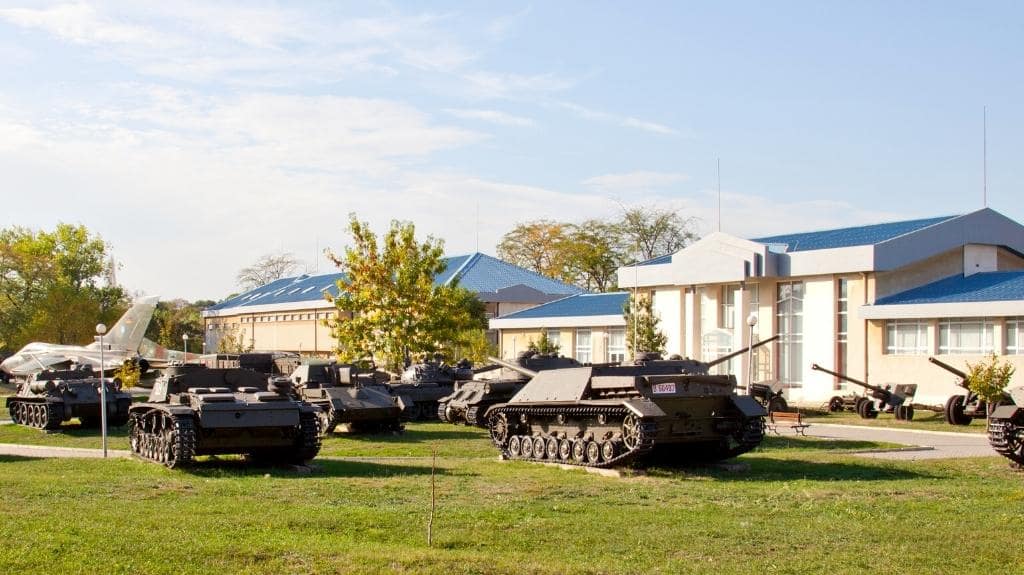
- National Museum of Military History. On the territory of the National Museum of Military History, you can discover tanks, missiles, aircraft, artillery, and military vehicles. They occupy a huge exhibition space of 53,820 sq. ft. (5,000 sq. m) indoors and 430,555 sq. ft. (40,000 sq. m.) outdoors. The museum dates back to 1906. This makes it the third oldest national museum institution in Bulgaria.
- National Polytechnic Museum. Inside the National Polytechnic Museum, you’ll see inventions from the last few centuries. You’ll be amazed at how our daily life has changed thanks to science and technology. Check out the collections on transportation, optics, time measurement, radio and television, photography and cinema, space, and computing. Don’t miss the instruments for space satellites and the laser demonstration.
- Socialist Art Museum. Since 2011, the Museum of Socialist Art has been one of the most unusual Sofia museums. Its exhibit walks you through the history of Bulgaria’s communist era from 1944 to 1989. A staggering red star guards the museum’s entrance. In the outdoor statue park, you can wander among busts, statues, and monuments of popular communist leaders, as well as sculptures of soldiers and workers.
- Museum of Illusions Sofia. With its more than 4,300 sq. ft. (400 sq. m) of exhibition space, the Museum of Illusions and its spellbinding art collection will provoke and enchant you. One of the newest museums in Sofia will provoke and enchant you. The museum likes to keep things fresh and opens new exhibits every year. This makes it one of the most popular institutions in Sofia. For this reason, we suggest grabbing your ticket in advance.
Visit Sofia for the Stunning Parks and Mountains

If you enjoy spending time outdoors, you should visit Sofia for the abundance of green spaces and hiking trails. Similar to London, which is designated as a forest, Sofia boasts vast parks. On top of this, several mountains surround the Bulgarian capital. Below, you’ll find the most gorgeous parks and mountains of Sofia.
- Vitosha Mountain. The highest mountain surrounding Sofia is one of the capital’s most recognizable symbols. Vitosha’s proximity to the city center makes it easily accessible by car, taxi, and public transportation. With its 7,520 ft. (2,290 m) in height, Vitosha Mountain is great for hiking and alpinism in summer, and fantastic for skiing and snowboarding in winter. If you decide to spend the night there, you can’t go wrong with the cozy 4* SPA Hotel Moreni.
- Boyana Waterfall. If you plan to visit the Boyana Church, we suggest you hike to Boyana Waterfall next. It’s the highest waterfall in Vitosha Mountain. You’ll reach its mighty cataracts in about an hour on foot. Beware that the hike is quite steep. However, the breathtaking panorama of Sofia and the 82-ft. (25-m) cascades are worth the sweat.
- Borisova Gradina Park. Named after the former Bulgarian King Boris, this is Sofia’s oldest and most popular park. It’s situated next to the city center and attracts countless visitors daily. Explore the centuries-old trees, cool restaurants, sports arenas, striking monuments, and beautiful ponds. Get lost in Borisova Gradina’s miles of tree-lined paths, enjoy an open-air performance, or sit on a bench and people-watch.
- South Park. Almost as popular as Borisova Gradina, South Park is only 15 minutes on foot from the National Palace of Culture. It’s a quick nature getaway for locals and tourists alike. If you like running, join the weekly 5-km Run (about 3.1 miles), taking place in South Park every Saturday morning regardless of the weather. Tip: Several other Bulgarian cities organize similar events, too. These include Plovdiv, Burgas, and Varna.
- Park Vrana. The garden belonged to the royal estate of the Bulgarian Kings Ferdinand I and Boris III. The son of the latter, Simeon Saxe-Coburg-Gotha, donated the park to the Sofia municipality. Park Vrana is an impressive work of landscape art, which dates back to the beginning of the 20th century. It’s on the outskirts of Sofia, approximately 7 mi (11 km) away from the city center. You can visit it on weekends and on official holidays.
Visit Sofia for the Scrumptious Cuisine and Shopping Deals

What do delectable dishes and shopping opportunities have in common? Well, in Sofia, you can enjoy tons of both at affordable prices. In this section, we’ve enlisted our favorite shopping and dining areas, as well as the typical regional dishes you must try.
- Vitosha Boulevard. Vitosha Boulevard starts with a pedestrianized area and continues past the National Palace of Culture, taking you all the way to the South Park. On the boulevard, and in the maze of smaller streets around it, the trendiest restaurants of Sofia coexist with funky street-food vendors. You can also explore countless shops, selling everything from shoes and clothes to jewelry, souvenirs, and books. If want to be in the middle of all this action when you visit Sofia, we recommend staying at the elegant Les Fleurs Boutique Hotel on Vitosha Boulevard.
- Pirotska Street. The best place in Sofia to shop for authentic souvenirs and trendy clothes from local brands is Pirotska Street. The pedestrian shopping area starts opposite the Banya Bashi Mosque and stretches for about 1,315 ft. (400 m). Large stores, tiny boutiques, and covered bazars offer reasonable prices and good quality products.
- Shopska salad. Bulgaria’s neighbors call this salad Bulgarian salad. Maybe because every Bulgarian loves the mix of tomatoes, cucumbers, onions, peppers, and white-brine cheese, sprinkled with parsley. Or perhaps because the colors of the salad – white, green, and red – are the same as the Bulgarian flag. Either way, when in Sofia, you must try this staple salad.
- Sirene po shopski. This vegetarian dish combines white-brine cheese (sirene), eggs, tomatoes, and butter. The ingredients simmer together in a clay pot to produce a simple yet heavenly delicious meal. Wash it down with a local red wine or beer.
- Sofiyska banitsa. This traditional Bulgarian pastry consists of layered dough sheets and a mixture of whisked eggs, yogurt, and white brine cheese. The dough in Sofiyska banitsa is rolled and then placed in a circular shape before baking. The result is a finger-licking culinary experience you’ll never forget. Enjoy it at breakfast, as a dessert, or as a snack between meals.
Is Sofia Worth Visiting? Now You Know the Answer

There you have it – the 33 best reasons to visit Sofia.
The Bulgarian capital seduces with its rich historical heritage, peculiar art collections, incredible shopping opportunities, and mouth-watering delicacies.
On top of that, it’s the perfect place to rejuvenate by exploring Sofia’s mineral springs, lush parks, and breathtaking mountains.
So, if you’ve been wondering why you should visit Sofia, we bet you found the answer already.
Now, we’re curious:
Have you been to Sofia, Bulgaria? Did you think it was worth the trip?
Share your experience in the comments below.

